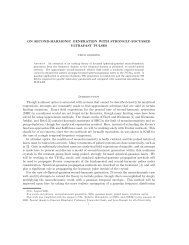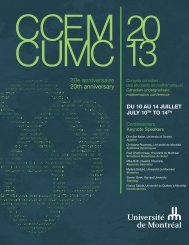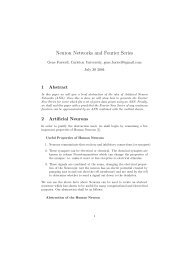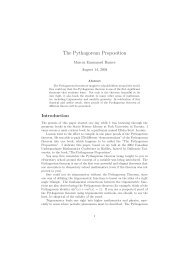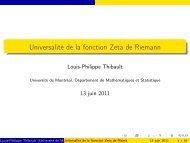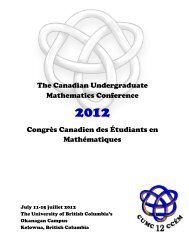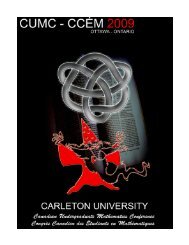booklet - CUMC - Canadian Mathematical Society
booklet - CUMC - Canadian Mathematical Society
booklet - CUMC - Canadian Mathematical Society
You also want an ePaper? Increase the reach of your titles
YUMPU automatically turns print PDFs into web optimized ePapers that Google loves.
THE GEOMETRY OF MUSICAL CHORDSAUDREY MORINOne of the most central features in music is harmony, or the assembly of tones insuccessive chords. Music theorists often refer to a notion of distance between chords,but traditional musical notation is very unhelpful in measuring it. In this talk, with thehelp of just a few tools from geometry and set theory, we will describe the constructionof musico-geometrical spaces of n-notes chords. First we assimilate the 12 pitch classeswith Z/12Z, so that n-notes chords can be represented as a point in a n-dimensionalorbifold. On these spaces it is then possible to define a metric, and thus a rigorousnotion of distance between chords. Moreover it is possible to trace paths on the orbifoldsrepresenting voice-leadings and chord progressions, providing a powerful toolin musical analysis. No notion of music theory will be assumed and many visual andauditory examples will be presented.MEMETIC PSO AND OTHER ALGORITHMS ON QUADRATIC BILEVEL PROBLEMSBEN MOOREIn this talk, we propose memetic particle swarm optimization (MPSO) to solve convexquadratic bilevel programming problems. Also, we compare MPSO with geneticalgorithm and stimulated annealing algorithms. Moreover, we illustrate the efficiencyof the proposed algorithm by solving several test problems from literature.ON THE PROBABILITY OF RELATIVE PRIMALITY IN THE GAUSSIAN INTEGERSBIANCA DE SANCTISThis talk will give an example of the interplay between probability, number theory,and geometry in the context of relatively prime integers in the ring of integers of anumber field. In particular, probabilistic ideas are coupled together with integer latticesand the theory of zeta functions over number fields in order to show thatP(gcd(z 1 , z 2 ) = 1) =1ζ Q(i) (2)where z 1 , z 2 ∈ Z[i] are randomly chosen and ζ Q(i) (s) is the Dedekind zeta functionover the Gaussian integers. Our proof outlines a lattice-theoretic approach to provingthe generalization of this theorem to arbitrary number fields that are principal idealdomains.PARTICLE SWARM OPTIMIZATIONBRIA KINDERSLEYParticle swarm optimization (PSO) is a stochastic optimization algorithm based onflocking behaviour of birds. The algorithm is attractively simple and adaptable and inrecent years PSO and its variants have been getting increased attention. This talk willintroduce the algorithm and certain variants, briefly review some theoretical analyses,and finally present some applications.19



